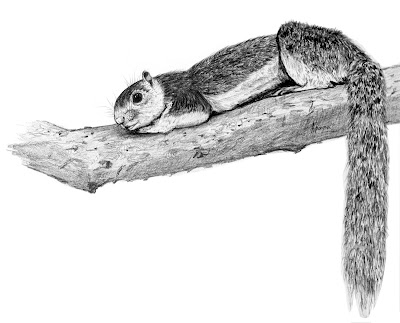We all know the diminutive scampering palm squirrel making forays into all branches of a fruiting tree assiduously collecting food. We have grown up watching their antics as they walk like a trapeze artist on suspended wires and leap unbelievably between treetops. A few of us must have seen the Indian giant squirrel also known as the Malabar giant squirrel, Kenchalilu in Kannada. But did you know that South India also hosts another giant squirrel? It’s called the grizzled giant squirrel.
The name is suggestive of its appearance – white interspersed between greyish brown hairs giving them the grizzled appearance. It is the smallest amongst the giant squirrel family. This not too well-known giant squirrel occurs in small numbers in Riparian forests (vegetation that generally grows alongside rivers in rain shadow region) of just 3 states, Karnataka, Tamil Nadu and Kerala and further south in Srilanka.
Tree canopy contiguity is very essential for the grizzled giant squirrel since are mainly arboreal just like their cousins –palm squirrel and follow a diet of mainly fruits, leaves, bark and some flowers. They are known to be partial to young tamarind, mango, Terminalia arjuna (Holematti) and Pongamia pinatta (Gobbarada mara) leaves and fruits. They also occasionally feast on insects and bird eggs.
Like Malabar giant squirrels, the grizzled also builds a roughly globular multilayer nest using twigs, leaves and tree fibers in layers and raises up to two young. They are highly territorial and very vocal.
They are known for their role as seed dispersers however the population of this charismatic species has reduced by 30% in the last 25 years due to habitat loss by deforestation, fragmentation of existing forest patches, excessive cattle grazing and harvesting of food trees by local people, forest fire and hunting of the animal for meat and fur.
Due to its low numbers with just over 500 and in decline this animal has been recognized as ‘Near threatened’ by International Union for Conservation of Nature, an international organization who is an authority on the status of the natural world.


